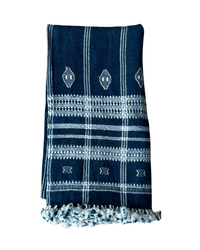
I’m so thrilled to share that Henriette von Stockhausen, VSP Interiors has kindly answered my questions about decorating with vintage textiles. I’ve admired her work for as long as I can remember, so it was an absolute honour to speak with her.
Henriette is the founder and creative director of VSP Interiors, a studio celebrated for its sensitive approach to historic buildings and classical architecture. Her signature style brings together antique furniture, vintage textiles and thoughtfully curated art to create interiors that are rich in character. Her talent for mixing modern elements into traditional spaces (and vice versa) results in timeless, yet distinctive designs.
VSP Interiors has earned numerous accolades and is regularly featured in top industry publications, including House & Garden, Country Life and Country & Town House. I think you’ll agree - her answers are absolutely brilliant and full of insight!
How do you go about incorporating vintage and antique textiles into your work?
I approach vintage and antique textiles almost as artworks in their own right - each piece has a story, a layer of history and an invitation to add soul to a space. Whether it’s a fragment of 18th-century embroidery, which I might use as a little decorative cushion or an old French linen/faded Kilimanjaro used as upholstery fabric, I let the textile and it’s size guide its placement. Often, I’ll upholster a headboard in an antique suzani and if it’s not big enough I use it as a panel within or as a curtain, or even sometimes frame it as wall art. These pieces are never afterthoughts - they’re integral to the scheme, chosen with the same care as one would a painting or sculpture to fit with the overall room scheme.
How best to display them?
It depends on the piece but my golden rule is always: give it room to breathe. Large antique tapestries can be magnificent on a panelled wall or as I have used in the US, as full room dividers on rods (I was lucky enough to find a pair from Julia Boston who specialises in beautiful Verdure tapestries - my favourite). They draw in the eye and ground the room. Smaller fragments can be made in beautiful cushions. I also love placing vintage textiles on the backs of armchairs or as bed throws - it’s about allowing the texture and timeworn beauty to shine without overwhelming the room. However, they often take the lead in a design as I tend to start my schemes with that special piece.
Where to start when using vintage textiles? Can they inspire a whole scheme?
Absolutely, as explained in my previous point…..they often do. I frequently begin a room’s palette or mood around one treasured piece - a beautiful antique suzani or an antique Anatolian tent trim used on the leading edges of curtains for instance. Vintage textiles provide instant depth; their faded colours are softer, more complex and lend a certain timelessness. If you’re just starting out - find one piece that speaks to you emotionally. From there, build outwards - picking out tones, textures and even motifs that echo its essence.
Unique creative ways of working with vintage textiles?
I’ve had fragments made into lampshades, incorporated rare borders into curtain edging and even used sections of antique suzanis as bed canopies. I also enjoy layering them - placing an antique textile over a more structured, tailored upholstery to create contrast and loosen the feel of a formal space. Sometimes we’ll rework a vintage fabric into a screen or headboard, giving new life and purpose to something that may have once been forgotten in a trunk.
Why do you love working with vintage textiles?
They carry a soul and tactility that no modern fabric can replicate. A softness in tonality and variation in thread and colour. I find beauty in their imperfections - the slight wear, the hand-stitched seams and the sense of age. They bring authenticity and depth to a room, creating something that feels both lived-in and loved. My training at Sotheby’s deepened my appreciation for provenance and working with vintage textiles allows me to honour craftsmanship from generations past.
Why would you recommend others to work with vintage textiles?
Because they bring immediacy and intimacy to a space. In a world of mass-produced materials, vintage textiles offer something utterly unique. No two pieces are the same. They also anchor a room with a sense of history and gravitas. For designers or homeowners looking to create timeless interiors, these textiles help steer away from the overly polished or contrived and instead invite warmth and personality.
What would your top 3 tips be for anyone looking to start using vintage textiles?
1. Start Small but be Selective – begin with cushions or a lampshade made from vintage fabric. Quality matters - look for natural fibres and handworked details.
2. Respect the Age – Some textiles are too delicate for heavy use. Understand their condition and choose their application wisely.
3. Let the Piece Speak – Don’t try to force it into a scheme. Let its colours, patterns or story inspire the surrounding design.





















































